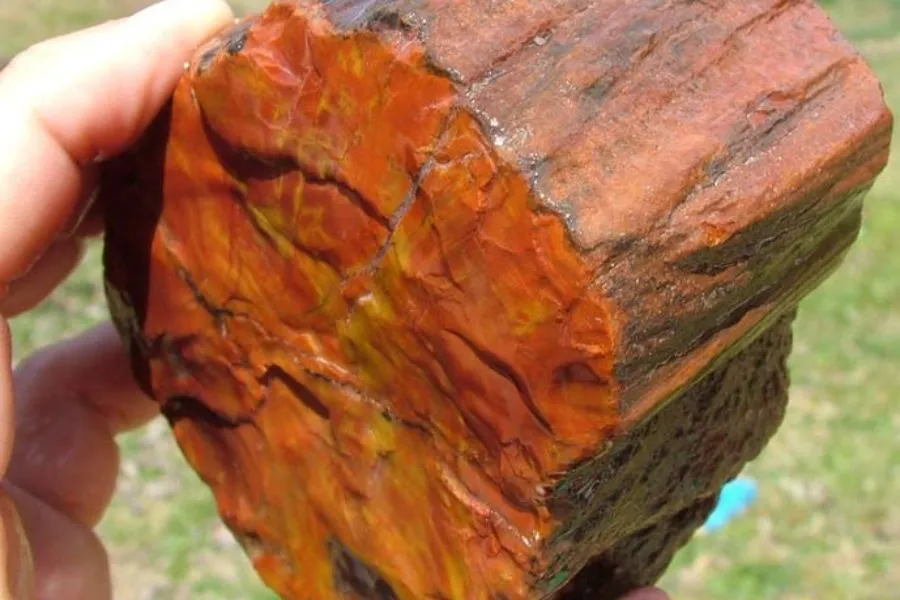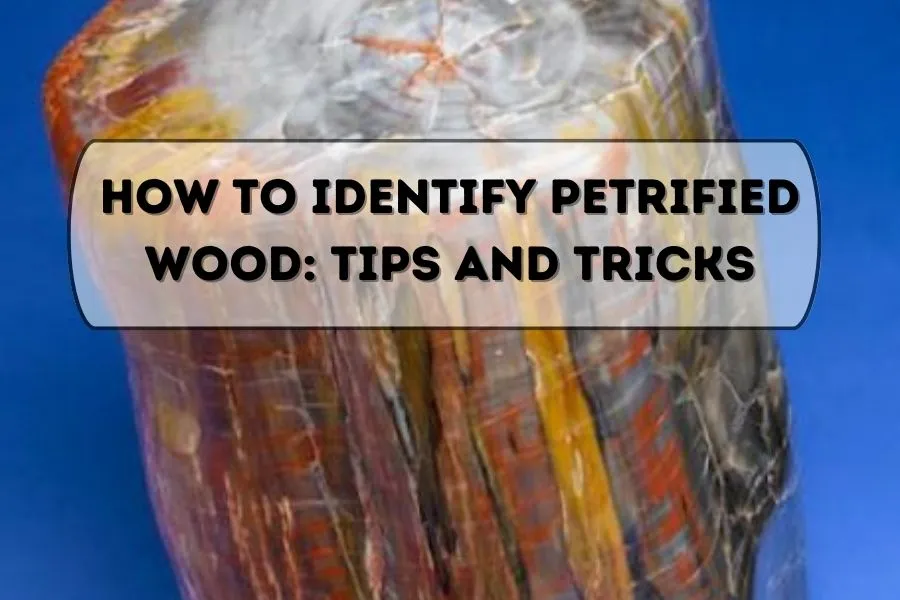Do you have a fascination with petrified wood? Have you ever stumbled across a strange-looking rock in the forest, and wondered if it could be petrified wood?
In this article, we’ll cover some tips and tricks about how to identify petrified wood. We’ll provide an overview of what exactly is and explain why it’s worth searching for. Then we’ll delve into the details – like examining physical traits and examining grain patterns – and teach you how to determine whether that mysterious rock is actually petrified wood or not.
So grab your magnifying glass (or microscope!) as we explore the world of petrification together!

What is Petrified Wood in a Nutshell?
Read our more extensive article “Petrified Wood: The Fascinating Process of Fossilization” for more extensive information but, in a nutshell, petrified wood is a type of fossilized wood that has been transformed into a stone-like material over millions of years.
It is created when organic matter, such as fallen trees and their remains, are exposed to minerals which replace the original organic matter with something more durable. As the petrification process takes place during thousands of years, the color, texture and structure of the wood can change drastically, creating visually stunning pieces of fossilized tree trunks and branches.
Where Is Petrified Wood Found and is it Hard to Find?
Petrified wood is most commonly found in dry desert areas, especially in the Western United States. It can also be found in other places around the world, such as Australia, Argentina, and India.
Petrified wood is not particularly hard to find if you look in the right places, although some pieces may be more difficult to locate than others.
What are the Uses of Petrified Wood?
Petrified wood is an amazing natural resource with a wide range of uses. It can be used to create stunning decorative pieces for the home, such as tables, countertops, fireplaces and more. Also, petrified wood can be used in landscaping designs to enhance the beauty and texture of outdoor living spaces. Since it is composed of minerals that have replaced the organic material of the original wood, it creates a mesmerizing array of colors and patterns.
The most common type of petrified wood is silicified wood, which has been replaced by quartz crystals. This type of petrified wood is often used to create decorative pieces because it provides a unique look that cannot be found in other materials.

Petrified wood also has various industrial applications, such as being used in sandblasting or grinding wheels and abrasive media for industrial machinery. Its hardness makes it ideal for these applications as it can stand up to wear and tear better than softer materials like asphalt or concrete.
It has been used in jewelry making for centuries due to its unique patterns and colors. The use of petrified wood in jewelry adds an extra layer of interest and beauty that is often appreciated by collectors.
Petrified wood also has many spiritual uses as well as medicinal benefits attributed to its presence. For example, it is believed that petrified wood brings energy and protection from negative influences while promoting progress towards personal goals when included in meditation practice or placed near bedsides for healing purposes.
Many cultures believe that petrified wood helps calm anxiety and stress levels while aiding with concentration during prayer or spiritual study sessions.
Tips And Tricks to Find Petrified Wood
Whether you’re just curious or you’re looking to start a petrified wood collection or even create a business out of selling petrified wood, one of the best places to look is at fossil shows. These shows are full of knowledgeable vendors and collectors who can help guide you in the right direction for finding petrified wood. You can also shop for genuine pieces from reputable dealers.
In addition to fossil shows, there are many online sources offering both genuine and imitation petrified wood. It’s important to research any seller before making a purchase, as it’s easy to get duped into buying fake pieces. Before purchasing, look up reviews on the seller or contact them with any questions you may have about their products.
However, if you’re feeling adventurous and want to try your hand at hunting for petrified wood yourself, then you can find some excellent specimens by scouring river beds or creek bottoms. It’s also possible to purchase land rights that allow you access to areas known for good finds.
READ THIS ARTICLE FOR MORE INFO: Where to Find Petrified Wood: The Best Locations Around the World

Tips & Tricks To Find It
- Look for petrified wood in areas that were once part of an ancient seabed or lakebed. These areas often have more petrified wood than other environments.
- Visit rock shops, flea markets, and antique stores to try and find pieces of petrified wood.
- Search online on websites like eBay and Etsy to see if there are any listings of petrified wood being sold.
- Seek out rockhounding clubs in your area, which often offer field trips to fossil sites that may contain petrified wood specimens.
- Attend gem and mineral shows as these events often showcase unique items like petrified wood pieces from around the world.
- Look in arid or desert regions such as Arizona, Utah, Nevada, and Idaho for ancient riverbeds with large deposits of petrified wood fragments.
- Ask locals in the area you’re searching for tips on where to look for petrified wood specimens in the region you’re visiting.
- Be sure to check local laws and regulations before you begin collecting in any public spaces or on private property. That way, you won’t be breaking any rules and can rest assured that your collection is completely legal.
Tips and Tricks to Identify Petrified Wood
As the incredible natural phenomenon that this is, how do we know if we have found actual petrified wood?? Since this process can take millions of years it feels a struck of luck to stumble upon them, right?
Here are some tips on how to identify petrified wood:
1) Look for colors: Petrified wood often has a range of colors such as black, gray, white, brown, red, pink and yellow. These colors can be mottled or distinct – look closely at the pattern of the colors to help differentiate them from other types of rocks.
2) Examine the texture: Petrified wood tends to have a glassy or silky feel while other types of rocks will usually feel rougher or grainier.
3) Check for evidence of its origin: Take note if shapes and structures may indicate signs of decay such as concentric circles found in the growth rings of a tree trunk. Also check for the presence of bark which is often preserved during the fossilization process.
4) Test it with acid: Petrified wood is less acidic than normal wood so you can use vinegar or lemon juice to test it. If droplets remain on its surface after a minute then it’s likely petrified wood but if they soak in then it’s something else entirely!

In Conclusion
Spotting petrified wood in its natural environment can be a challenge and relies on keen observation – but with the right identification tips, it’s possible to find it. A little detective work and the right identification tips, you can find and appreciate this fascinating rock! And who knows…start a business.


